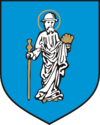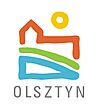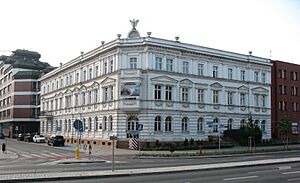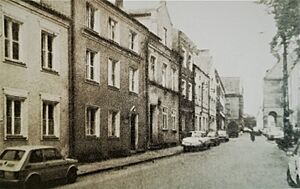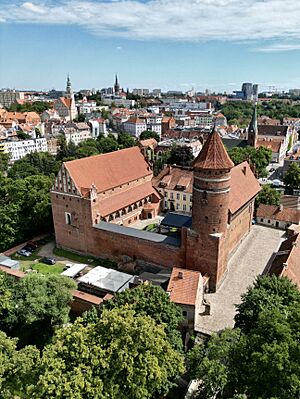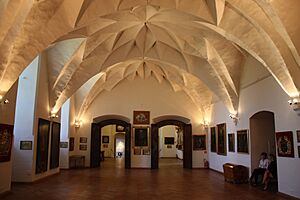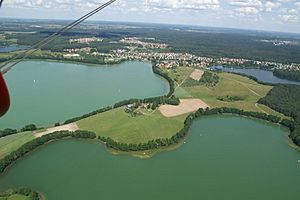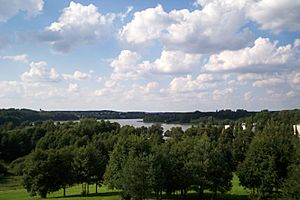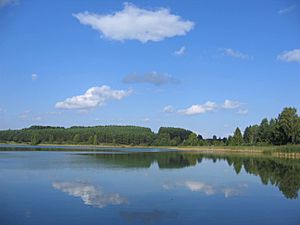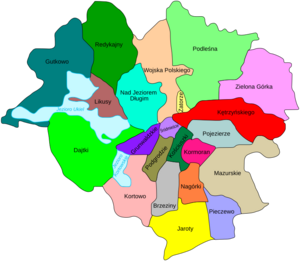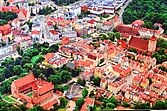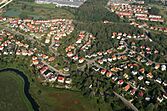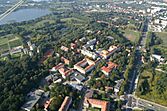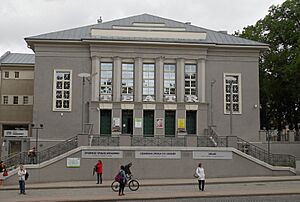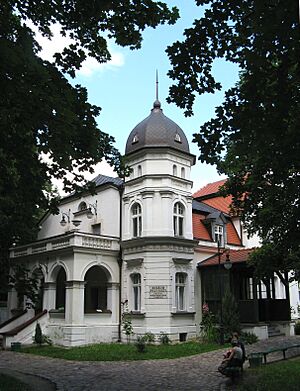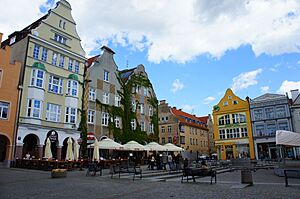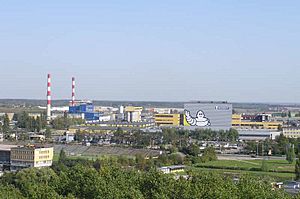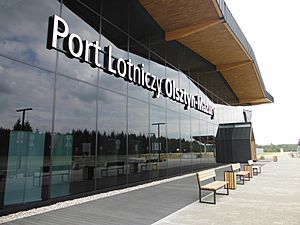Olsztyn facts for kids
Quick facts for kids
Olsztyn
|
|||||
|---|---|---|---|---|---|
|
|||||
|
|||||
| Motto(s):
Olsztyn – Miasto Młode Duchem…
(Olsztyn – a city young in spirit…) |
|||||
| Anthem: O Warmio moja miła | |||||
| Country | |||||
| Voivodeship | |||||
| County | city county | ||||
| Established | 14th century | ||||
| City rights | 1353 | ||||
| Area | |||||
| • Total | 88.328 km2 (34.104 sq mi) | ||||
| Highest elevation | 154 m (505 ft) | ||||
| Lowest elevation | 88 m (289 ft) | ||||
| Population
(31 December 2021)
|
|||||
| • Total | 169,793 |
||||
| • Density | 1,950/km2 (5,100/sq mi) | ||||
| Time zone | UTC+1 (CET) | ||||
| • Summer (DST) | UTC+2 (CEST) | ||||
| Postal code |
10-001 to 11–041
|
||||
| Area code(s) | +48 89 | ||||
| Car plates | NO | ||||
| Climate | Dfb | ||||
| Primary airport | Olsztyn-Mazury Airport | ||||
| Highways | |||||
| Website | http://www.olsztyn.eu | ||||
Olsztyn is a cool city in northern Poland, located on the Łyna River. It's the main city of the Warmian-Masurian Voivodeship. About 170,000 people live here.
Olsztyn is the biggest city in a region called Warmia. Since 1999, it has been the capital of its voivodeship (a type of province). In the same year, the University of Warmia and Masuria was created by joining three local universities.
Today, the Olsztyn Castle is a museum. It hosts concerts, art shows, and movies. This makes Olsztyn a popular place for tourists to visit. The city is also home to the Archbishop of the Roman Catholic Archdiocese of Warmia.
Some of the most important places to see are the old medieval town and the St. James Pro-cathedral. This church is over 600 years old. The main market square is part of the European Route of Brick Gothic. The pro-cathedral is one of Poland's best examples of Gothic architecture.
For many years, Olsztyn has been known for its great quality of life. It ranks high in things like income, jobs, and safety. It's considered one of the best places in Poland to live and work. It's even one of the happiest cities in the country!
Contents
History of Olsztyn
Early Days and Medieval Times
![]() Teutonic Order 1353–1454
Teutonic Order 1353–1454
![]() Kingdom of Poland 1454–1455
Kingdom of Poland 1454–1455
![]() Teutonic Order 1455–1463
Teutonic Order 1455–1463
![]() Kingdom of Poland 1463–1569
Kingdom of Poland 1463–1569
![]() Polish–Lithuanian Commonwealth 1569–1772
Polish–Lithuanian Commonwealth 1569–1772
![]() Kingdom of Prussia 1772–1871
Kingdom of Prussia 1772–1871
![]() German Empire 1871–1918
German Empire 1871–1918
![]() Weimar Germany 1918–1933
Weimar Germany 1918–1933
![]() Nazi Germany 1933–1945
Nazi Germany 1933–1945
![]() People's Republic of Poland 1945–1989
People's Republic of Poland 1945–1989
![]() Republic of Poland 1990–present
Republic of Poland 1990–present
In 1334, a watchtower was built by the Łyna River. A few years later, in 1346, the area was cleared for a new settlement. The Teutonic Knights started building a castle in 1349. This castle was meant to protect against the Baltic Prussians.
Olsztyn officially became a town in October 1353. The German name "Allenstein" came from the river's old name, Alna, which meant "hind" (a female deer). Local Poles called it Holstin or Olsztyn. The castle was finished in 1397.
The town was taken by the Kingdom of Poland in 1410 during a war. It was taken again in 1414. But it was given back to the monastic state of the Teutonic Knights each time.
In 1440, the city joined the Prussian Confederation. This group rebelled against the Teutonic Knights in 1454. They wanted to join the Kingdom of Poland. King Casimir IV Jagiellon agreed. The townspeople took the castle and accepted the Polish king as their ruler. The Teutonic Knights took the city back the next year. But Polish troops recaptured it in 1463. In 1466, a peace treaty confirmed Olsztyn as part of the Kingdom of Poland.
Modern Times and Important Changes

From 1516 to 1521, Nicolaus Copernicus lived in the town castle. He was an administrator and helped defend Olsztyn during the Polish-Teutonic War. Copernicus also helped bring new Polish settlers to the region. This time was like a "golden age" for Olsztyn. Trade and crafts grew because the city was on an important trade route.
During this period, Copernicus visited the city several times. Other important Polish thinkers and writers also came. The St. James' Pro-Cathedral, a famous building, was finished then.
Things got harder in the 1620s due to a fire and a sickness. In 1655 and 1708, Swedish troops attacked the city. In 1710, many people died from sicknesses like the bubonic plague.
In 1772, Olsztyn became part of the Kingdom of Prussia. Its economy struggled at first. Many Poles were forced to adopt German culture. A count in 1770 showed 1,770 people lived there, mostly farmers.
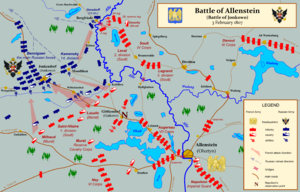
On February 3, 1807, the Battle of Allenstein happened near the city. The French Army, led by Napoleon Bonaparte, fought the Russian army. Napoleon visited Olsztyn that day. His victory here helped his army move north.
The city started growing again after 1818. More German settlers arrived. By 1825, there were 1,341 Germans and 1,266 Poles. The city faced a sickness and hunger crisis in the early 1830s. However, it grew again under Polish mayor Jakub Rarkowski (1836-1865). He expanded and modernized the city. He even helped hide Polish rebels during the January Uprising.
The first German newspaper started in 1841. In 1863, Polish historian Wojciech Kętrzyński was arrested here for helping Polish rebels. A hospital was built in 1867.
In 1871, Olsztyn became part of the German Empire. Two years later, a railway connected the city to Toruń. Even with efforts to make people more German, Olsztyn remained an important Polish center. Its first Polish language newspaper, the Gazeta Olsztyńska, started in 1886. The city's services grew quickly: gas in 1890, telephones in 1892, water in 1898, and electricity in 1907.
World Wars and Modern Olsztyn

During World War I in 1914, Russian troops took Olsztyn. But the German Army quickly won it back in the Battle of Tannenberg.
After World War I, a vote was held in 1920. People decided if they wanted to stay with Germany or join Poland. Polish people in the area faced unfair treatment. Polish meetings were broken up, and people were threatened. Despite this, the vote showed most people wanted to stay with Germany.
Between the World Wars, many Polish groups worked in Olsztyn. These included scouting groups and a Polish bank. They also had a school and a library. After the Nazis took power in Germany in 1933, Polish people and Jews in Olsztyn faced more difficulties. Many Polish activists were forced to leave. The Gazeta Olsztyńska newspaper was shut down. Its editor and others were arrested and died.
During World War II, Olsztyn was a place where people were forced to work. The city was also involved in terrible medical experiments on patients at a hospital. At least 5,000 people were killed.
On January 22, 1945, near the end of the war, the Soviet Red Army took over the city. Much of Olsztyn was damaged. Many German residents left. The remaining people, mostly Poles, faced hardships.
In May 1945, a Polish government was set up in the region. This was later accepted by other countries. By October 1945, the remaining German population was moved out. New Polish settlers came, many from areas of Poland taken by the Soviet Union. The city was rebuilt over the next few years.
Olsztyn Today
In 1945, a match factory opened, becoming the city's first big factory after the war. A tire factory, now Michelin, started in 1967. The city's boundaries grew a lot in 1966 and 1987.
In 1956, Olsztyn had the biggest Polish protest supporting the Hungarian Revolution of 1956. In 1973, a planetarium opened to celebrate 500 years since Nicolaus Copernicus's birth. In 1989, the old Gazeta Olsztyńska building became a museum. Pope John Paul II visited in 1991. In 1999, the University of Warmia and Mazury in Olsztyn was founded. It is now one of the largest universities in northeastern Poland.
Olsztyn became the capital of the Warmian-Masurian Voivodeship in 1999.
Olsztyn Castle's Story
The Olsztyn Castle was built between 1346 and 1353. It had one main building and a courtyard. You could get to the castle by a drawbridge over the Łyna River. Walls and a moat surrounded it. Another part of the castle was built in the 15th century. The tower, built in the 14th century, was made taller in the early 1500s to 40 meters high. At the same time, the castle walls were raised to 12 meters. The castle walls were connected to the city walls, making it a strong defense for the city.
The castle was very important in the wars between Poland and the Teutonic Knights. After a big battle in 1410, Poles took it. During another war (1454–66), the castle changed hands several times. In 1521, the Knights tried to attack the castle and town, but the defense was strong. Nicolaus Copernicus himself helped prepare Olsztyn's defense in 1520.
In the 1500s, two important bishops of Warmia lived here: Johannes Dantiscus and Marcin Kromer. Kromer dedicated a chapel inside the castle. Over time, the castle became more of a home than a military fort. In 1779, another bishop, Ignacy Krasicki, also stayed here.
After Olsztyn became part of Prussia in 1772, the castle became government property. In 1845, the drawbridge was replaced by a path connecting the castle to the city. From 1901 to 1911, the castle was repaired. Some changes were made that changed its original look.
In 1945, the castle became home to the Masurian Museum. Today, it's called the Museum of Warmia and Masuria. Many popular events are held there, like "castle evenings" and "Sundays in the Museum."
The Jewish Community in Olsztyn
Historically, Jews were allowed to trade in Olsztyn during medieval times. However, in 1718, a bishop banned Jewish trade in the city. This ban was not always successful, as local traders still complained about Jewish merchants. Permanent Jewish settlement began around 1780, when Jews were allowed to live outside the city walls. In 1814, the first Jewish store opened.
The Jewish community grew, but city leaders tried to limit it. In 1850, a law was passed to fine or jail anyone who housed a "wandering" Jew.
The Jewish community officially started in 1820. A prayer room was set up. In 1877, the community bought land and built a synagogue. A Jewish cemetery was also created. At its largest, the Jewish population reached 448 people in 1933.
During a terrible event called Kristallnacht, the synagogue was destroyed. It was later used as a bomb shelter. Today, a sports club is on the site of the former synagogue.
By 1939, only 135 Jews remained in the city. Most others had left the country. Those who stayed were later sent to difficult camps. In 1946, 16 people who survived the Holocaust settled in Olsztyn. Most of them later moved to Israel. The Jewish cemetery no longer exists.
The famous Jewish architect Erich Mendelsohn was born in Olsztyn. He designed a special building, called the Mendelsohn house, next to the cemetery. This building has been restored.
Geography of Olsztyn
Olsztyn is in the northeast part of Poland. This area is known as the "Thousand Lakes" region.
Green Spaces and Forests
More than half of the city's forests are part of the Municipal Forest (1050 hectares). This area is mainly used for fun activities and tourism. Inside the Municipal Forest, there are two special areas for rare plants called Mszar and Redykajny.
The city also has many parks and green spots (560 hectares). There are also three cemeteries that are over a century old. You can find 910 protected trees and groups of trees, like beech, oak, maple, and lime trees.
Lakes in the City
Olsztyn is in a region with many lakes, forests, and flat lands. There are 15 lakes right inside the city limits. Thirteen of these lakes are larger than 1 hectare. All together, the lakes in Olsztyn cover about 725 hectares. This is about 8.25% of the city's total area.
| Lake | Area (ha) | Maximum depth (m) |
|---|---|---|
| Lake Ukiel (a.k.a. Jezioro Krzywe) | 412 | 43 |
| Lake Kortowskie | 89.7 | 17.2 |
| Lake Track (a.k.a. Trackie) | 52.8 | 4.6 |
| Lake Skanda | 51.5 | 12 |
| Lake Redykajny | 29.9 | 20.6 |
| Lake Długie | 26.8 | 17.2 |
| Lake Sukiel | 20.8 | 25 |
| Lake Tyrsko (a.k.a. Żbik or Duży Żbik) | 18.6 | 30.6 |
| Lake Stary Dwór | 6.0 | 23.3 |
| Lake Siginek | 6.0 | insufficient data |
| Lake Czarne | approximately 1.3 | insufficient data |
| Lake Żbik (a.k.a. Mały Żbik) | approximately 1.2 | insufficient data |
| Lake Pereszkowo | approximately 1.2 | insufficient data |
| Lake Mummel | approximately 0.3 | insufficient data |
| Lake Modrzewiowe | 0.25 | insufficient data |
Olsztyn's Climate
Olsztyn has a climate that is like an oceanic climate or a humid continental climate. This means it has warm summers and cold, snowy winters.
| Climate data for Olsztyn (1991–2020 normals, extremes 1951–present) | |||||||||||||
|---|---|---|---|---|---|---|---|---|---|---|---|---|---|
| Month | Jan | Feb | Mar | Apr | May | Jun | Jul | Aug | Sep | Oct | Nov | Dec | Year |
| Record high °C (°F) | 12.2 (54.0) |
16.7 (62.1) |
23.9 (75.0) |
30.2 (86.4) |
31.5 (88.7) |
33.7 (92.7) |
36.1 (97.0) |
36.2 (97.2) |
34.6 (94.3) |
25.9 (78.6) |
17.8 (64.0) |
13.2 (55.8) |
36.2 (97.2) |
| Mean daily maximum °C (°F) | 0.4 (32.7) |
1.8 (35.2) |
6.2 (43.2) |
13.3 (55.9) |
18.6 (65.5) |
21.7 (71.1) |
23.8 (74.8) |
23.4 (74.1) |
18.1 (64.6) |
11.8 (53.2) |
5.5 (41.9) |
1.7 (35.1) |
12.2 (54.0) |
| Daily mean °C (°F) | −2.0 (28.4) |
−1.1 (30.0) |
2.2 (36.0) |
7.9 (46.2) |
12.9 (55.2) |
16.1 (61.0) |
18.3 (64.9) |
17.8 (64.0) |
13.2 (55.8) |
8.0 (46.4) |
3.3 (37.9) |
−0.4 (31.3) |
8.0 (46.4) |
| Mean daily minimum °C (°F) | −4.4 (24.1) |
−3.8 (25.2) |
−1.5 (29.3) |
2.6 (36.7) |
7.1 (44.8) |
10.7 (51.3) |
13.2 (55.8) |
12.7 (54.9) |
8.9 (48.0) |
4.8 (40.6) |
1.2 (34.2) |
−2.6 (27.3) |
4.1 (39.4) |
| Record low °C (°F) | −30.6 (−23.1) |
−30.6 (−23.1) |
−23.5 (−10.3) |
−9.7 (14.5) |
−4.8 (23.4) |
−0.5 (31.1) |
4.0 (39.2) |
1.9 (35.4) |
−4.2 (24.4) |
−11.0 (12.2) |
−20.2 (−4.4) |
−26.0 (−14.8) |
−30.6 (−23.1) |
| Average precipitation mm (inches) | 42.1 (1.66) |
33.1 (1.30) |
39.4 (1.55) |
37.5 (1.48) |
59.8 (2.35) |
70.1 (2.76) |
88.0 (3.46) |
63.8 (2.51) |
58.5 (2.30) |
57.7 (2.27) |
47.0 (1.85) |
45.4 (1.79) |
642.4 (25.29) |
| Average extreme snow depth cm (inches) | 9.5 (3.7) |
9.7 (3.8) |
6.5 (2.6) |
1.7 (0.7) |
0.0 (0.0) |
0.0 (0.0) |
0.0 (0.0) |
0.0 (0.0) |
0.0 (0.0) |
0.8 (0.3) |
3.2 (1.3) |
6.2 (2.4) |
9.7 (3.8) |
| Average precipitation days (≥ 0.1 mm) | 17.37 | 15.00 | 14.13 | 12.40 | 13.50 | 14.30 | 14.43 | 13.33 | 13.03 | 14.13 | 15.57 | 17.63 | 174.84 |
| Average snowy days (≥ 0 cm) | 18.4 | 17.6 | 9.6 | 1.3 | 0.0 | 0.0 | 0.0 | 0.0 | 0.0 | 0.5 | 4.1 | 12.5 | 64.0 |
| Average relative humidity (%) | 88.2 | 85.0 | 77.6 | 69.9 | 70.4 | 72.6 | 74.7 | 75.3 | 80.7 | 84.7 | 89.7 | 89.8 | 79.9 |
| Source 1: Institute of Meteorology and Water Management | |||||||||||||
| Source 2: Meteomodel.pl (records, relative humidity 1991–2020) | |||||||||||||
City Districts and Administration
Olsztyn is divided into 23 main districts. These districts help organize the city and its services.
| District | Population | Area | Density |
|---|---|---|---|
| Brzeziny | 1,456 | 2.25 km2 (0.87 sq mi) | 647.1/km2 |
| Dajtki | 5,863 | 7.5 km2 (2.9 sq mi) | 781.7/km2 |
| Generałów | 6,500 | no data | no data |
| Grunwaldzkie | 6,027 | 1.46 km2 (0.56 sq mi) | 4,128.1/km2 |
| Gutkowo | 2,256 | 7.2 km2 (2.8 sq mi) | 313.3/km2 |
| Jaroty | 29,046 | 4.82 km2 (1.86 sq mi) | 6,026.1/km2 |
| Kętrzyńskiego | 7,621 | 4.83 km2 (1.86 sq mi) | 1,577.8/km2 |
| Kormoran | 16,166 | 1.1 km2 (0.4 sq mi) | 14,696.4/km2 |
| Kortowo | 1,131 | 4.22 km2 (1.63 sq mi) | 268/km2 |
| Kościuszki | 6,704 | 1.18 km2 (0.46 sq mi) | 5,681.4/km2 |
| Likusy | 2,286 | 2.1 km2 (0.8 sq mi) | 1,088.6/km2 |
| Mazurskie | 4,615 | 5.98 km2 (2.31 sq mi) | 771.7/km2 |
| Nad Jeziorem Długim | 2,408 | 4.23 km2 (2 sq mi) | 569.3/km2 |
| Nagórki | 12,538 | 1.69 km2 (0.65 sq mi) | 7,418.9/km2 |
| Pieczewo | 10,918 | 2.24 km2 (0.86 sq mi) | 4,874.1/km2 |
| Podgrodzie | 11,080 | 1.35 km2 (0.52 sq mi) | 8,207.4/km2 |
| Podleśna | 10,414 | 9.93 km2 (3.83 sq mi) | 1,048.7/km2 |
| Pojezierze | 13,001 | 2.39 km2 (0.92 sq mi) | 5,439.7/km2 |
| Redykajny | 1,555 | 6.1 km2 (2.36 sq mi) | 254.9/km2 |
| Śródmieście | 3,448 | 0.58 km2 (0.22 sq mi) | 5,944.8/km2 |
| Wojska Polskiego | 6,759 | 5.03 km2 (2 sq mi) | 1,343.7/km2 |
| Zatorze | 6,988 | 0.45 km2 (0.17 sq mi) | 15,528.9/km2 |
| Zielona Górka | 1,015 | 6.44 km2 (2.49 sq mi) | 157.6/km2 |
There are also many smaller areas within Olsztyn. These include Jakubowo, Karolin, Kolonia Jaroty, Kortowo II, Łupstych, Niedźwiedź, Piękna Góra, Podlesie, Pozorty, Skarbówka Poszmanówka, Słoneczny Stok, Stare Kieźliny, Stare Miasto, Stare Zalbki, Stary Dwór, and Track.
Culture and Fun in Olsztyn
Theatres for Shows
- Stefan Jaracz Theatre (started in 1925) hosts the International Theatre Festival DEMOLUDY.
- Puppet Theatre offers fun shows.
Cinemas for Movies
- Helios
- Multikino
Museums to Explore
- Museum of Warmia and Mazury (Muzeum Warmii i Mazur) is Olsztyn's biggest museum.
- Gazeta Olsztyńska House (Dom "Gazety Olsztyńskiej")
- Museum of Nature (Muzeum Przyrody)
- Museum of Sports (Muzeum Sportu)
- Muzeum Nowoczesności (Museum of Modernity)
Amazing Architecture
The historic center of Olsztyn is called the Old Town (Stare Miasto). It has many old and beautiful buildings:
- The Gothic castle of Warmian Chapter, built in the 14th century, was once home to Nicolaus Copernicus. Now it's a museum.
- Gothic St. James' Pro-cathedral has a mix of Gothic, Renaissance, and Baroque styles inside.
- The Old Town Hall on the Market Square was built in the mid-14th century.
- The Gazeta Olsztyńska House at the Targ Rybny ("Fish Market") is now a museum.
- You can see parts of the old town walls and the High Gate.
- Our Lady Queen of Poland church.
- A monument to Nicolaus Copernicus.
- Park Zamkowy (Castle Park).
- The Baroque Archpresbyter's Palace (Pałac Archiprezbitera).
- The Gothic Revival Church of the Salvator.
Other cool buildings outside the Old Town include:
- The New City Hall.
- The Jewish Tahara house in Olsztyn, built in 1911-1912 by Erich Mendelsohn.
- A modern planetarium with cool mosaics by Stefan Knapp.
- The Jerusalem Chapel, built in 1565.
- The Neogothic Sacred Heart church, built in 1901–1902.
- The Church of St. Lawrence in the Gutkowo district, built in the late 14th century.
- Monuments to the Home Army and Stefan Jaracz, plus the White Eagle Column.
- The Railway Bridge over the River Łyna gorge, built in 1872–1873.
- The Main Post Office.
- The Warmian-Masurian Voivodeship office.
- Instytut Północny im. Wojciecha Kętrzyńskiego ("Wojciech Kętrzyński Northern Institute").
- Park Centralny (Central Park).
- The Książnica Polska building, which has one of the oldest working passenger elevators in Poland and Europe.
- The FM- and TV-mast Olsztyn-Pieczewo – at 360 meters high, it's the tallest structure in Poland since the Warsaw radio mast fell.
Music Scene
Olsztyn is home to the National Symphony Orchestra, which performs great music.
Economy and Jobs
The Michelin Polska tyre company is the biggest employer in the Warmia and Masuria region. Other important businesses in Olsztyn include food processing and making furniture.
Getting Around Olsztyn
Road Travel
Bus System
Olsztyn has a bus network with 36 different lines. This includes 6 lines that go to nearby towns and 2 lines that run at night.
Trolleybus History
In 1939, a trolleybus line started in Olsztyn. It helped replace the old tram network. During World War II, women often drove these trolleybuses. The trolleybus system had 4 lines. It stopped running on July 31, 1971.
Train Connections
Olsztyn has train connections to many big cities in Poland. These include Warsaw, Kraków, Gdańsk, and Wrocław. You can also take trains to other towns in the region. Olsztyn Główny is the main train station. There are plans to build a new station building.
Tram Network

The city's first tram line was built in 1907. It grew over the years but stopped running in 1965.
In 2006, city leaders thought about bringing trams back to help with traffic. Studies showed it was possible. An 11-kilometer long tram network was built between 2011 and 2015. This was the first new tram system built in Poland in 55 years! Fifteen new trams were ordered. Now, there are five tram lines running.
In 2024, a 6-kilometer extension was finished. A Turkish company will provide 24 more trams for the network.
Air Travel
The region and city are served by Olsztyn-Mazury Airport. This airport has regular international flights. It's located in Szymany, about 58 kilometers south of Olsztyn. The airport has flights to places like London, Dortmund, and Kraków. It also has seasonal flights to Rzeszów and Wrocław.
Education and Learning
- University of Warmia and Mazury in Olsztyn is a major university.
- Masurian Institute (started in 1943) is a research center.
Sports and Athletes
Olsztyn has many sports teams and famous athletes:
- Indykpol AZS Olsztyn – a men's volleyball team. They have won the Polish championship five times.
- Stomil Olsztyn – a men's football team. They played in Poland's top league from 1994 to 2002.
- Warmia Olsztyn – a men's handball team.
- Warmia Olsztyn – one of the city's oldest football clubs.
- AZS UWM Trójeczka Olsztyn – a men's basketball team.
- WMPD Olsztyn – a men's rugby team.
- Budowlani Olsztyn – a wrestling team.
- Joanna Jędrzejczyk (born 1987) is a famous Polish Muay-Thai and MMA fighter. She used to be a UFC Women's Strawweight Champion.
- Łukasz Gikiewicz (born 1987) and Rafał Gikiewicz (born 1987) are Polish footballers.
- Filip Kurto (born 1991) is a Polish footballer.
- Olsztyn Lakers – an American football team.
Olsztyn has also hosted the Memorial of Hubert Jerzy Wagner, an international volleyball tournament. The Tour de Pologne, a big cycling race, has also been held in Olsztyn many times.
Famous People from Olsztyn

Many interesting people have connections to Olsztyn:
- Johannes von Leysen (1310–1388), who helped found the town.
- Nicolaus Copernicus (1473–1543), the famous astronomer who lived and worked here.
- Marcin Kromer (1512–1589), a Polish historian and diplomat.
- Hugo Haase (1863–1919), a German politician.
- Feliks Nowowiejski (1877–1946), a Polish composer.
- Erich Mendelsohn (1887–1953), a famous German-Jewish architect.
- Günter Wand (1912–2002), a German conductor.
- Józef Glemp (1929–2013), a Polish bishop.
- Juliusz Machulski (born 1955), a Polish film director.
- Krzysztof Hołowczyc (born 1962), a Polish rally driver.
- Piotr "Peter" Wiwczarek (born 1965), a Polish musician.
- Joanna Jędrzejczyk (born 1987), a famous fighter.
- Artur Szalpuk (born 1995), a Polish volleyball player and World Champion.
Olsztyn's Global Connections
Consulates in Olsztyn
Olsztyn has honorary consulates for Belarus, Germany, and Lithuania. These offices help people from those countries.
Twin Towns and Sister Cities
Olsztyn is connected with other cities around the world. These are called "twin towns" or "sister cities":
|
|
|
Olsztyn is also part of the Federation of Copernicus Cities. This group connects cities where Nicolaus Copernicus lived and worked. Other cities in this group include Bologna, Frombork, Kraków, and Toruń. The main office for this group is in Olsztyn's Planetarium and Astronomical Observatory. This observatory is in a former water tower built in 1897.
Images for kids
See also
 In Spanish: Olsztyn para niños
In Spanish: Olsztyn para niños








